Natalia Kraevskaia’s Preview on Exhibition “The Echo of Nature”

Exhibition “The Echo of Nature” will be organized at Vietnam Fine Arts Museum from 11 to 15 Aug. Below is the preview of art researcher Natalia Kraevskaia on this exhibition:
“For us, living in harmony with nature is a source of artistic inspiration and creativity. At the epoch of the dramatic social and political changes, of rapid information technologies development, of high-speed urbanization, unseen before, there is a lot of confusion and ambiguity in a way of creating art, especially for the young artists. The fear to fall into a trap of common contemporary trends, of cheap success and calculated career-building strategies led us to decision to choose a separate path in the current context of Vietnamese art. For us it means ‘to return’ to featuring nature which is so unpopular now. At the same time portraying nature for us doesn’t simply purport painting en plein air and capturing pretty landscapes, we intend to go beyond and to create art which is based on the spirit of nature and which establishes profound connection between nature and human souls”.
This brief text which sounds like a passage from a manifesto statement is in fact a collection of phrases gleaned from my personal correspondences with the young artists who call themselves “Mobile Artists Group”.
My first encounter with these artists happened more than a year ago, after their first exhibition “Colors of Nature” at Nguyen Art gallery in Hanoi in January 2013, and paradoxically began not from admiration and compliments but from a critical regard and unanswered questions. My first impression after visiting the show which introduced landscape art was an obvious resemblance of the exhibited works with the landscape paintings of Russian Peredvizhniki (The Itinerants or The Wanderers in English), a group which was active in the late 19th century. The similarities with the Itinerants, besides the name of the group itself, related to the choice of subject matter, and more importantly with their recognizable manner of depicting nature. The Itinerants’ landscapes were known for their broad, plain expanses, travel-worn roads across vast fields, the simple beauty of river banks and river twists, and a special light which painters can capture only en plein air and which strengthens the sentimental effect of the scene. All this I found in the art of the Vietnamese group and was intrigued by this seeming coincidence. The discussion I raised on an online arts website Hanoigrapevine engaged many other visitors to the exhibition. Those familiar with European art history expressed a similar perception. We found the influence of the Itinerants to be so strong that even the scenery appeared for us more Eastern – European than Vietnamese. While many questions were brought up in the online forum I was very surprised to get a comprehensive response from Trinh Lien, the leader of the Mobile Artists Group in which he admitted the impact of the Russian Itinerants upon the young Vietnamese painters of the group. Moreover, I was highly pleased to recognize that it was a deliberate choice.

My critical attitude and hesitation with the artists’ conceptual position gave way to respect for their serious approach to landscape painting based on the deep and thorough studies of art history and on a conscious choice of the model to follow. The Mobile Artists Group embraced the ideas of eternal beauty, artistic sincerity, the immortal charm of nature and its capacity to evoke lofty sentiments in a human heart. Certainly, such an idealistic approach is astonishing and also touching in a time when art critics debate the issue “is a picture still alive” and ponder over the future of landscape painting. The declaration of the members of the Mobile Artists Group about their further plans “to develop technique, to enrich feelings and expressions and sharing the common purpose to find the individual ways in art” in order to achieve perfection in capturing their favourite subject – nature– incited me to follow their creative process for the last two years. The present exhibition is the result of their studies, reflections and experiments.
Looking at the practice of the artists from the Mobile Artists Group it should be kept in mind that there is no significant tradition of landscape in the Vietnamese Fine Art. While landscape views copied from reality prevailed in Western landscape art for centuries and imaginary landscape in its classical Chinese form of mountain-water painting enjoyed a prestigious position in East Asian Art long before the emergence of painting in Vietnam, beautiful scenery could occasionally be seen in Vietnamese fine art of the 20th century though for the most part only as a background in paintings of other thematic genres. Seen in this context, the initiative of the young artists to explore landscape painting as subject may be interpreted as their wish to fill the lacuna in Vietnamese artistic practice.

Being familiar with the history of landscape painting in both Europe and Asia the young artists borrowed and adjusted to their own aims the ideas and aesthetic strategies of different art movements: getting inspiration directly from nature and capturing it’s qualities of light and colour forms which is coming from the French Barbizon school, the sophisticated employment of light – shadow play and spontaneity of the Italian Macchiaioli, the skill to create the effect of color vibration and movement, which was elaborated by the Impressionists, to name a few. The central principles for these young Vietnamese paysagists inherited from the Russian Itinerants are their adherence to open-air painting, a representation of spirituality of the landscape art and desire to examine correlations between grandeur of nature and human experiences and emotions. The longing to grasp the inner holy sense of nature’s existence, to overcome the separation of people from nature, has inspired artists to share with the public their deep love for the homeland.
The rural landscapes of Trinh Ngoc Lien reflect his tireless experimentation with painting technique – his brushstrokes and usage of primary and complementary colors; his move from realistic steadiness to Impressionists’ motion and changeability. His earlier paintings, which depict trees, forests, river-beds and village roads open out to more expansive vistas and elicit the sense of being a distant observer. The latest works which demonstrate the artist’s evident engagement with land by including views of ponds, narrow paths and fields, of corners in village court-yards, contrarily, mirror the scenery from a close distance and create for the audience a more intimate feeling of being part of these plain, unpretentious but evocative and affecting surroundings.

Lien’s desire for transient optical effects and his attempts to reflect the essence of the scene by capturing ephemeral and elusive light is shared by Duy Hoa, whose works are also reminiscent of the Impressionists’ practice. The refusal of black paint and the absence of contrasts along with the usage of subdued colour patches impart an air of subtlety and elegance in the artist’s work. Duy Hoa’s village scenery is far from being a simple topographical record but rather reflects the different states of, nature and variety of visual perceptions of nature, an objective central also to the art of the Itinerants.
While some viewers might have an appreciation for Hoa’s blurry colours and vagueness of shapes which evoke the sensation of indeterminacy, others may be attracted to the diversity of realistic countryside views by Le The Anh. Unlike the prevalent pattern, where, unfortunately for the majority of people visiting painting exhibitions and commercial galleries in Vietnam today, the word landscape is associated with a rice field and peasants in conical hats scattered on the verdure, the imagery repertoire of Le The Anh is quite broad and includes scenes from rural life, the stilt houses of the ethnic minorities, small shreds of fields and vegetable gardens, nooks and corners of peasants yards with traditional wells, shaky bamboo fences and domestic utensils. Employing vivid colours and a precision of details Le The Anh intends to create trustworthy views and to emphasize the richness and splendour of nature.
A similar goal can be seen in the works by Nguyen Ngoc Tuan who through a minute description of details and painstaking study of light attains a powerful effect of twilight and moonlit night. The skillful combination of dark and bright intense colors leads to a new color harmony and adds to a realistic landscape the flavor of mystery. Tuan, like nearly all the members of the Mobile Artists Group, selects typical landscape motifs and with a touch of the artist – realist depicts the beauty of tropical plants and of countryside dwellings. His rural views are perceived as fictitious and enigmatic. And while Tuan intently investigates different ways to portray the particular magnificence of vegetation in Vietnam it remains only a component of his compositions.
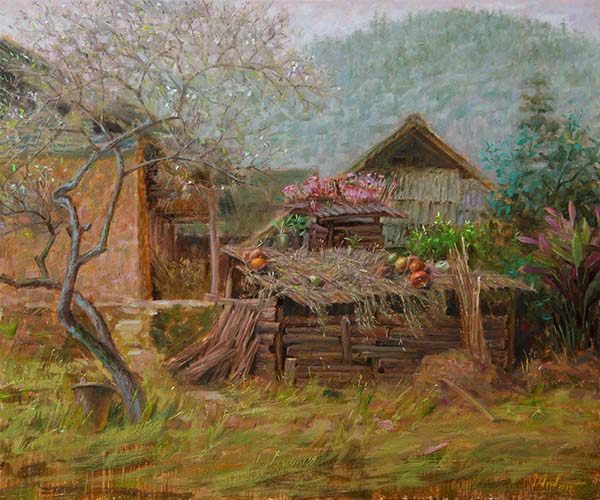
Le Thuy, another member of the Mobile Artists group, does quite the reverse and reduces the landscape to the fragments where wild or cultivated plants and flowers are the central subject. She peers into the calm corners of gardens, overlooking their ordinary beauty and using vigorous and joyous colors of luminous intensity celebrates the diversity and splendor of vegetation. The intention of Le Thuy to make her works at first appear archaic articulates her wish to describe a continuity of traditions and steadfast concept of nature’s beauty.
Though most of the artists in the exhibition have chosen landscapes as their main subject others expand their narration about countryside life to include traces of people’s presence. Thus Nguyen Duy Tung focuses specifically on village dwellings, drawing the simple but graceful peasants’ houses and courtyards. His reduced palette of grey and mud-brown along with laconically shaped buildings obliges impression of tranquility and the immutability of rural life. The pictures of peasants’ habitations formally free from human presence also create a feeling of solitude and question the village scene as a social space.
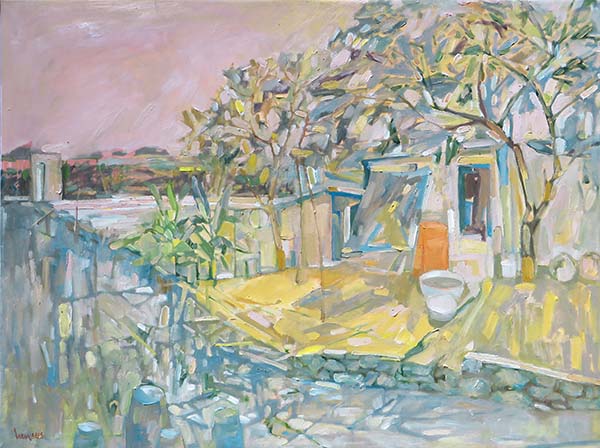
The monotony of the village scenery and village life which drive younger generations to cities can probably explain the general trend in landscape art where the urban landscape dislodges the rural. The striking shift of the urban theme in Vietnamese contemporary art (especially during the last decade) is a separate topic for study and critical writing. The creative production of artists related to depictions of the city embraces different media including installation, video and sound art, photography and personal and collaborative research projects with multimedia outlet. However, the customary practice of painting the cityscapes ascending to the famous Hanoi views by Bui Xuan Phai have never declined.
In the present exhibition the city is represented in the art of Dang Hiep who depicts his affinity for architectural components and structures of a city’s old streets, narrow alleys and cramped yards. Attentive to the details in his realistic works, the artist meanwhile doesn’t aim to simply render the recognizable sites; he experiments with the various modes of generalization in order to introduce to viewers a typical image of the Vietnamese city. Like the other members of the Mobile Artists Group, Hiep elaborates the issue of lighting by intentionally playing with light spots and shadows so to reproduce the characteristic transparency of Hanoi air on a sunny day. Addressing a rural life in a number of works the artist, same as in his urban scenery, displaces an interest in dwellings, domestic constructions or in general architectural and structural peculiarities and details of the habitation.
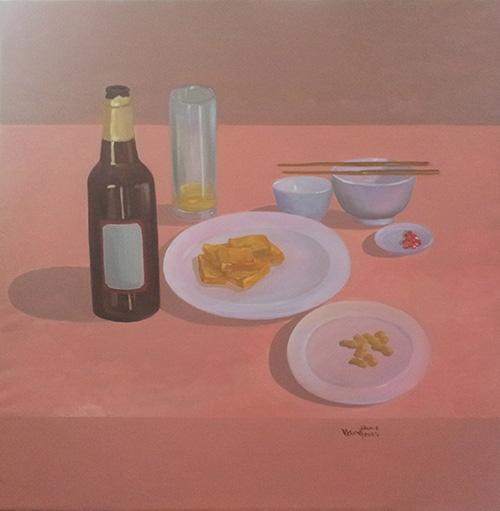
The works of Dang Huu diverge from the main topic of this group exhibition. An artist who previously explored the rural landscape has this time chosen to display his paintings of another genre – still life. His earlier still life paintings which feature arrangements of jugs, bottles, bowls and vases remind us in their composition and muted color palette of the works of one of the most famous still life painters of the 20th century, Giorgio Morandi. These objects pulled out from their functional context are intended to be admired for their pure aesthetics. The recent paintings by Dang Huu differ by the choice of more commonplace domestic objects and their odd set-up which gravitates towards event narration. Compared with his earlier works, the colour scheme used here marks a preponderance of flatness. This probably helps to accentuate the banality of the scene. Refining his technical skills in this traditional genre the artist goes from imitation towards interpretation of object.
This exhibition on the whole shouldn’t be judged as the overall results of a group artistic practice, rather it is a modest step of young enthusiasts on their way towards creative discoveries. Inspired by the majesty and mystique of nature, the artists share with the public their ideas and sentiments in ingenuous and audacious hope that others too will hear the echo of Nature.
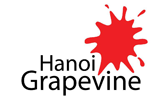

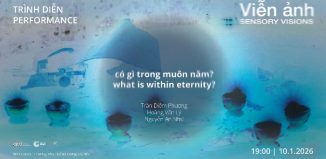














Cảm ơn nhà phê bình nghệ thuật Natalia Kraevskaia về một bài viết rất sâu sắc !
Very interesting.
Em ngưỡng mộ và tự hào về thầy và nhóm HSLĐ ^^ !
Bài viết khá khô khan, thiếu cảm xúc khiến những người muốn xem tranh cũng ngại ngần!
Có nhiều đoạn dịch khá ngô nghê, giống như dịch qua “google” vậy, xin đơn cử một ví dụ:
“Trong khi cách nhìn phong cảnh, mô phỏng từ thực tế chiếm ưu thế đối với hội họa Phương Tây suốt nhiều thế kỷ và phong cảnh tưởng tượng của hình thức hội họa cổ điển Trung Quốc trong với những bức tranh về sơn thủy đã chiếm một vị trí uy tín trong lịch sử hội họa Đông Nam Á rất trước khi có sự xuất hiện của những bức tranh phong cảnh tại Việt Nam, nơi mà cảnh quan đẹp được nhìn thấy trong Mỹ thuật VN ở thế kỷ 20 với đặc điểm là những ghi chép ký họa”.
Tôi không hiểu “trong với những” và “rất trước khi” có nghĩa là gì?
Tôi đọc nhiều trang mỹ thuật, thấy có tác giả viết về mỹ thuật ký là Linh Cao viết rất hay, mềm mại, về chủ đề khó viết này. Rất mong được đọc những bài viết như vậy.